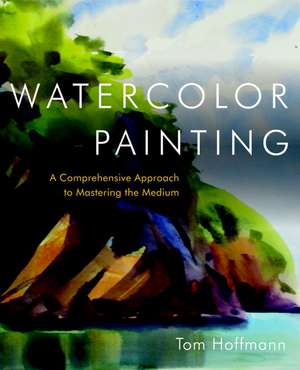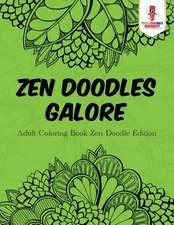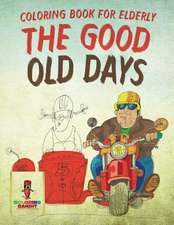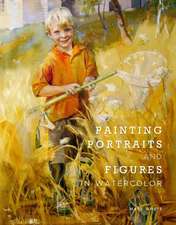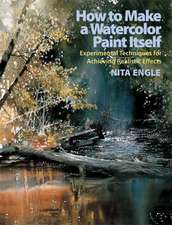Watercolor Painting
Autor T Hoffmannen Limba Engleză Paperback – 6 ian 2013
Experienced teacher and acclaimed artist Tom Hoffmann offers a unique, inquiry-based approach that shows you how to translate any subject into the language of watercolor. With Hoffmann as your guide, you’ll learn the key questions to ask yourself at every turn and time-tested methods to help you reach solutions.
Hoffmann’s thorough explanations and step-by-step demonstrations delineate the process of composing a painting in watercolor, while art from more than thirty-five past and present masters, including John Singer Sargent, Ogden Pleissner, George Post, Emil Kosa, Jr., Mary Whyte, Trevor Chamberlain, Lars Lerin, Torgeir Schjølberg, Piet Lap, Leslie Frontz, and Alvaro Castagnet serve to illustrate and inspire. Whether you’re a serious beginner or a seasoned practitioner, this book will guide you toward the all-important balance between restraint and risk-taking that every watercolorist seeks.
Preț: 210.17 lei
Nou
Puncte Express: 315
Preț estimativ în valută:
40.23€ • 42.29$ • 33.46£
40.23€ • 42.29$ • 33.46£
Carte disponibilă
Livrare economică 06-20 decembrie
Livrare express 21-27 noiembrie pentru 63.80 lei
Preluare comenzi: 021 569.72.76
Specificații
ISBN-13: 9780823006731
ISBN-10: 0823006735
Pagini: 160
Ilustrații: full colour throughout, 140 4-colour illustrations
Dimensiuni: 237 x 290 x 21 mm
Greutate: 1.23 kg
Editura: Watson–Guptill
ISBN-10: 0823006735
Pagini: 160
Ilustrații: full colour throughout, 140 4-colour illustrations
Dimensiuni: 237 x 290 x 21 mm
Greutate: 1.23 kg
Editura: Watson–Guptill
Notă biografică
Tom Hoffmann is a practicing artist and teacher who has been dedicated to the watercolor medium for more than thirty years. He received his BFA from Amherst College and an MA in Art Education from the University of London. His paintings have been exhibited at the Seattle Art Museum, the Frye Museum, Tacoma Art Museum, the Copley Society of Boston, and the Park Avenue Armory in New York City. He currently teaches three levels of watercolor classes at the Gage Academy of Art in Seattle, Washington.
Extras
"Having observed the progress of many watercolor students over the years, I can make a few informed generalizations about the limits we put on our own range. Most common of all is the tendency to stop short of the deep, rich, darks the image may require, This is why it is especially important to ask late in the painting process: Are the darks dark enough?
Of course, certain technnical concerns can affect how dark the paint can be, but these can usually be solved with a piece of practice paper and a spirit of inquiry. The trickiest issues seem to have more to do with psychology than technique. For example, all watercolor paint dries lighter than it appears when it is wet. This is always true. You knew it the first week you started painting, right? There comes a point after which it is just plain silly to use this as a reason for not getting dark enough darks. You've got practice paper. Do the work, and make sure. You are the one who is in charge of your paintings."
Of course, certain technnical concerns can affect how dark the paint can be, but these can usually be solved with a piece of practice paper and a spirit of inquiry. The trickiest issues seem to have more to do with psychology than technique. For example, all watercolor paint dries lighter than it appears when it is wet. This is always true. You knew it the first week you started painting, right? There comes a point after which it is just plain silly to use this as a reason for not getting dark enough darks. You've got practice paper. Do the work, and make sure. You are the one who is in charge of your paintings."
Cuprins
Watercolor Painting
Contents
Introduction: Understanding Watercolor
Chapter One: Translating a Subject into the Language of Watercolor
Being Mindful of Your Subject
Revisiting Your Purpose
Identifying the Tricky Parts
Knowing Where to Begin
Knowing When to Stop
Maintaining Intentionality with Your Marks
Recognizing What Works
Using the Language of Form
Chapter Two: Knowing What Not to Paint
Identifying the Major Shapes
Creating a Five-Value Monochrome Study
Evaluating a Simplified Study
Creating a Two-Layer Geometric Sketch
Thinking about Stopping
Creating a Three-Layer Thumbnail Sketch
Chapter Three: Seeing in Layers
Resolving an Image through Layers
Learning to Exercise Restraint
Identifying Individual Layers
Evaluating the Layers
Chapter Four: Understanding Value
Identifying the Lightest Part of the Picture
Reserving the Whites
Reserving Non-White Elements
Identifying the Darkest Part of the Picture
Bracketing the Values
Knowing How Dark You Can Go
Critiquing the Darks
Knowing When to Depart from “Accuracy”
Chapter Five: Sharing Control of Wetness
Working with Hard and Soft Edges
Planning the Wetness of the Paper
Providing Enough Time for Each Task
Gauging How Much Paint You Need
Gauging the Wetness of the Brush
Rewetting an Area
Knowing When to Depart from “Accuracy”
Chapter Six: Getting the Most out of Color
Serving Your Main Goals with Color
Evaluating Your Palette
Mixing Your Colors
Identifying the Dominant Color
Evaluating the Effects of Color Temperature
Knowing When to Depart from “Accuracy”
Enlivening Your Darks
Choosing Colors for Your Neutrals
Chapter Seven: Developing an Instinct for Composition
Sketching Your Subject
Translating Form into Content
Knowing When to Depart from “Accuracy”
Creating the Illusion of Space
Being Mindful of Abstraction
Establishing Balance
Chapter Eight: Becoming Your Own Teacher
Identifying the Qualities of a Good Teacher
Establishing Who Is in Charge
Painting for Its Own Sake
Devising Alternate Strategies
Identifying What Worked Well
Expanding Your Range
Asking the Questions
Index
Contents
Introduction: Understanding Watercolor
Chapter One: Translating a Subject into the Language of Watercolor
Being Mindful of Your Subject
Revisiting Your Purpose
Identifying the Tricky Parts
Knowing Where to Begin
Knowing When to Stop
Maintaining Intentionality with Your Marks
Recognizing What Works
Using the Language of Form
Chapter Two: Knowing What Not to Paint
Identifying the Major Shapes
Creating a Five-Value Monochrome Study
Evaluating a Simplified Study
Creating a Two-Layer Geometric Sketch
Thinking about Stopping
Creating a Three-Layer Thumbnail Sketch
Chapter Three: Seeing in Layers
Resolving an Image through Layers
Learning to Exercise Restraint
Identifying Individual Layers
Evaluating the Layers
Chapter Four: Understanding Value
Identifying the Lightest Part of the Picture
Reserving the Whites
Reserving Non-White Elements
Identifying the Darkest Part of the Picture
Bracketing the Values
Knowing How Dark You Can Go
Critiquing the Darks
Knowing When to Depart from “Accuracy”
Chapter Five: Sharing Control of Wetness
Working with Hard and Soft Edges
Planning the Wetness of the Paper
Providing Enough Time for Each Task
Gauging How Much Paint You Need
Gauging the Wetness of the Brush
Rewetting an Area
Knowing When to Depart from “Accuracy”
Chapter Six: Getting the Most out of Color
Serving Your Main Goals with Color
Evaluating Your Palette
Mixing Your Colors
Identifying the Dominant Color
Evaluating the Effects of Color Temperature
Knowing When to Depart from “Accuracy”
Enlivening Your Darks
Choosing Colors for Your Neutrals
Chapter Seven: Developing an Instinct for Composition
Sketching Your Subject
Translating Form into Content
Knowing When to Depart from “Accuracy”
Creating the Illusion of Space
Being Mindful of Abstraction
Establishing Balance
Chapter Eight: Becoming Your Own Teacher
Identifying the Qualities of a Good Teacher
Establishing Who Is in Charge
Painting for Its Own Sake
Devising Alternate Strategies
Identifying What Worked Well
Expanding Your Range
Asking the Questions
Index
